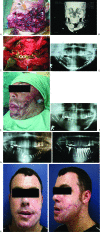Treatment protocol for high velocity/high energy gunshot injuries to the face
- PMID: 23449809
- PMCID: PMC3348750
- DOI: 10.1055/s-0031-1293518
Treatment protocol for high velocity/high energy gunshot injuries to the face
Abstract
Major causes of facial combat injuries include blasts, high-velocity/high-energy missiles, and low-velocity missiles. High-velocity bullets fired from assault rifles encompass special ballistic properties, creating a transient cavitation space with a small entrance wound and a much larger exit wound. There is no dispute regarding the fact that primary emergency treatment of ballistic injuries to the face commences in accordance with the current advanced trauma life support (ATLS) recommendations; the main areas in which disputes do exist concern the question of the timing, sequence, and modes of surgical treatment. The aim of the present study is to present the treatment outcome of high-velocity/high-energy gunshot injuries to the face, using a protocol based on the experience of a single level I trauma center. A group of 23 injured combat soldiers who sustained bullet and shrapnel injuries to the maxillofacial region during a 3-week regional military conflict were evaluated in this study. Nine patients met the inclusion criteria (high-velocity/high-energy injuries) and were included in the study. According to our protocol, upon arrival patients underwent endotracheal intubation and were hemodynamically stabilized in the shock-trauma unit and underwent total-body computed tomography with 3-D reconstruction of the head and neck and computed tomography angiography. All patients underwent maxillofacial surgery upon the day of arrival according to the protocol we present. In view of our treatment outcomes, results, and low complication rates, we conclude that strict adherence to a well-founded and structured treatment protocol based on clinical experience is mandatory in providing efficient, appropriate, and successful treatment to a relatively large group of patients who sustain various degrees of maxillofacial injuries during a short period of time.
Keywords: face; gunshot injuries; high energy; high velocity; treatment protocol.
Figures


References
-
- Gibbons A J, Patton D W. Ballistic injuries of the face and mouth in war and civil conflict. Dent Update. 2003;30:272–278. - PubMed
-
- Yetiser S, Kahramanyol M. High-velocity gunshot wounds to the head and neck: a review of wound ballistics. Mil Med. 1998;163:346–351. - PubMed
-
- Cohen M A, Shakenovsky B N, Smith I. Low velocity hand-gun injuries of the maxillofacial region. J Maxillofac Surg. 1986;14:26–33. - PubMed
-
- Glapa M, Kourie J F, Doll D, Degiannis E. Early management of gunshot injuries to the face in civilian practice. World J Surg. 2007;31:2104–2110. - PubMed
-
- Williams C N, Cohen M, Schultz R C. Immediate and long-term management of gunshot wounds to the lower face. Plast Reconstr Surg. 1988;82:433–439. - PubMed
LinkOut - more resources
Full Text Sources
Miscellaneous
